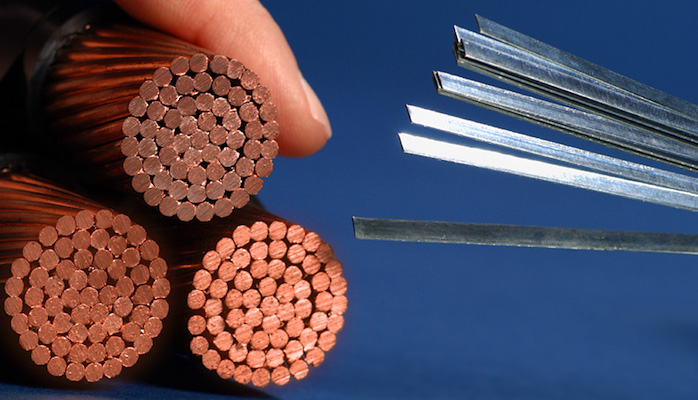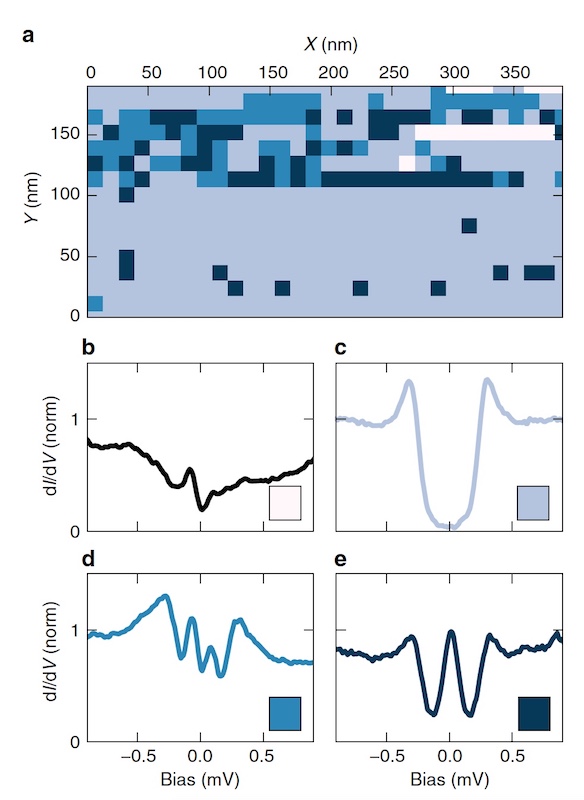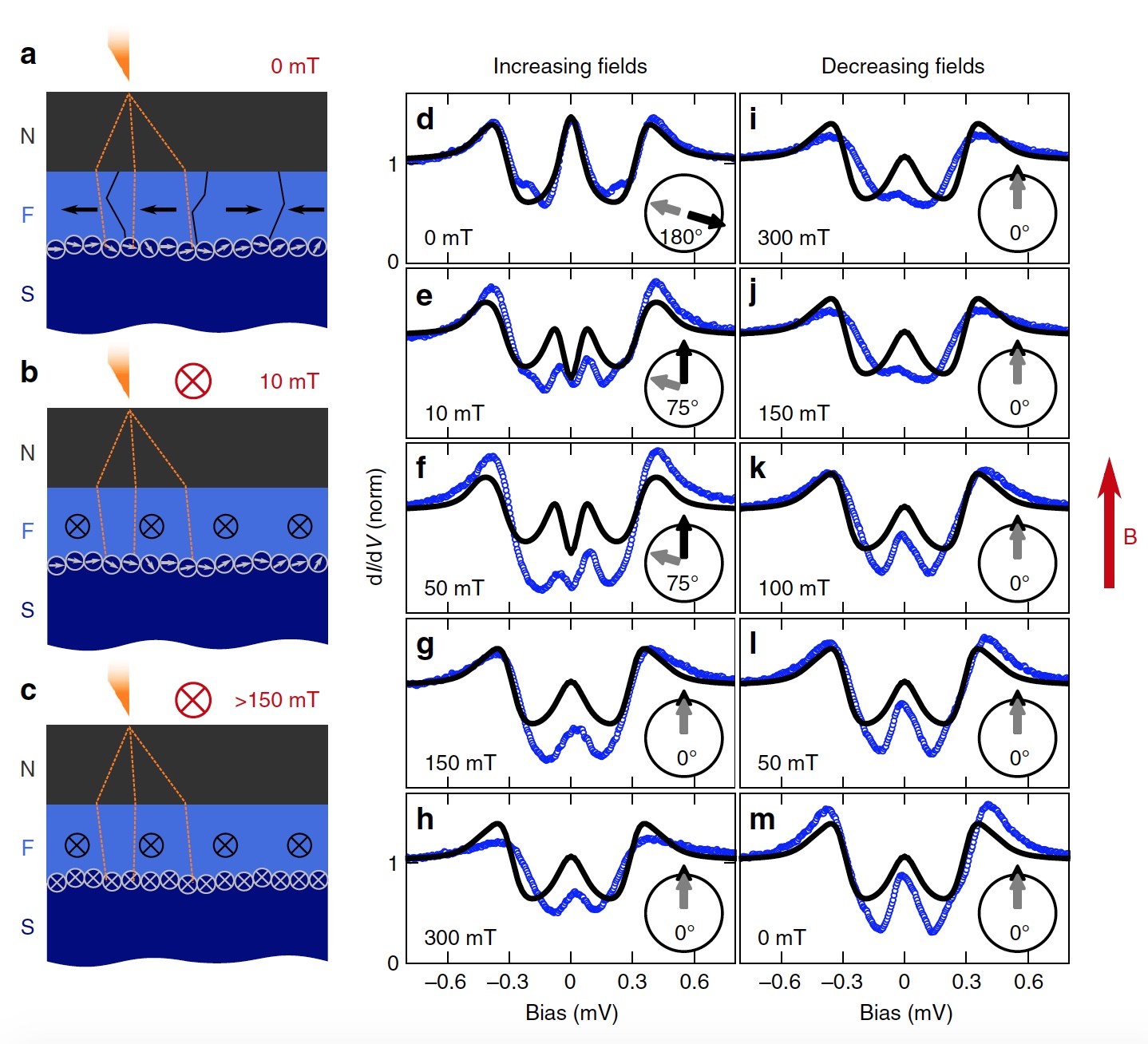Superconductor + ferromagnet: the study of triplet Cooper pairs

Earlier we already got acquainted with superconductors , however this material hides many more interesting things. Superconductors play a very important role in the work of supercomputers. What exactly, you ask? In solving the problem of minimizing the heat generated in the process of work of these makhin. Today we will consider the study of "non-standard" superconductors with triple pairs of electrons with the opposite spin moment. Sounds intriguing, right? What it is, how it works and how scientists have figured out this, we learn from their report. Go.
Basis of research
As we know, a “standard” superconductor has pairs of electrons with opposite spin, which are called Cooper, in honor of Leon Cooper, who described the theory of such pairs back in 1956.

Leon Cooper
However, if the superconductor is in contact with an unevenly ordered ferromagnet, an exotic type of superconductivity arises on the surface. In such a situation, there are electrons that are interconnected in one of the three formats of the spin-triplet state.
Multipleness * - characterization of the spin of an atom or molecule. For example, a singlet is a system of two particles whose total spin is 0.At the moment, there is no material evidence of such phenomena, although the emergence of superconductivity with the help of ferromagnets is observed. However, scientists are not trying to prove, albeit theoretically, the existence of this phenomenon.
This study presents a theoretical model demonstrating the characteristic features in the density of quasiparticles, which is a sign of the presence of triplet pairs with the same spin. The main tool was scanning tunneling spectroscopy (STS), which was used to measure the density of states to identify the spin characteristics of triplet pairs. But the main test was Al / EuS / Ag - aluminum / europium (II) sulfide / silver.
Many researchers believe that the hybrid heterostructures of a superconductor-ferromagnet are one of the main components of the foundation of computing technology of the future. Cooper pairs with the same spin can transfer spin information without energy dissipation * , thereby significantly reducing its consumption.
Energy dissipation * - speaking, exaggerated, the transfer of energy into heat.However, at the moment it has not yet been possible to prove the existence of triplets with the same spin; more precisely, it was impossible to distinguish such triplets from triplets with mixed spin. This is due to the lack of a distinctive signature, which would help distinguish two states.
In addition, it is worthwhile to understand that the spin-dependent phase transitions will be much weaker on the side of the superconductor in the S / F structure. To test all these theories, the researchers decided to study the local density of states (LDOS) in the S / FI / N structure, where S is a superconductor, FI is a ferromagnetic insulator with non-collinear magnetization, and N is a normal (normal) conductor.
Scientists note that no one has conducted similar experiments before them. They were the first to determine that states with the same spin and mixed spin differ at the level of LDOS structures.
The resulting triplet zone around zero energy leads to the formation of symmetric two-peak structures around a zero bias voltage in LDOS. The width of the triplet zone exclusively depends on the ratio of states with the same spin and states with mixed spin. The same is directly a consequence of the presence of a ferromagnet in the immediate vicinity of the superconductor.
Research results
After conducting a series of LDOS calculations, scientists isolated theoretical differential conductivity (dI / dV), which can be calculated by introducing certain experimental parameters as, so to speak, variables. These parameters include the temperature (above 0) and the amplitude of the modulation of the voltage added to the offset, which is necessary for the measurement.

Layer thickness of the sample Al / EuS / Ag.
The calculated results were compared with tunnel spectroscopy, that is, with the measured results, dI / dV between the normal metal and the Al / EuS / Ag sample. During the measurements made by the STS microscope, the temperature was 290 mK (millikelvin), which is well below the critical superconductivity temperature for the Al layer, which is Tc = 1.7 K.
Researchers also note their important observation - the formation of an oxide layer between Al and EuS layers. This neoplasm plays an important role in the formation of noncollinear magnetic ordering, which in turn plays one of the main roles in the formation of triplet pairs.

Results of tunnel spectroscopy of the Al / EuS / Ag sample.
Next, the scientists decided to characterize the three-layer sample by measuring the tunnel spectrum. The measurements were categorized into 4 groups (image above: be).
Group B corresponds to the location of the microscope needle, where the tunnel junction is too noisy for spectroscopy or the superconductivity itself is suppressed. Such results were rarely observed and were associated with defects in the sample surface.
Group C corresponds to a rigid zone *, which is quite common in spin-independent tunneling and is often observed in Al / Ag reference samples.
Hard and soft gap * - if the density of states tends to zero in an expanded range of energies, then this is called a hard zone; if the density of states tends to zero for only one energy value, then this is already a soft zone.
The most important for this study are groups D and E, which were called the triplet zone and the spectrum of peaks of zero offset, respectively.
The data obtained must be combined into a single clear system. It is for this purpose that the model of noncollinear magnetization was created. Based on theoretical data, scientists have suggested that the occurrence of signs characteristic of the triplet zone corresponds to areas with at least two directions of magnetization (that is, with noncollinear magnetization). The researchers believe that these two pronounced zones are due to the structure of the sample, but rather to the inner layer of EuS and the surface layer of Al (image a, b and c below).

The dependence of the model on changes in the magnetic field.
In addition, the ferromagnetic interface must provide a certain degree of spin mixing between equally oriented magnetic domains.
Considering that the results of measurements largely correspond to the BCS theory, which is based on Cooper pairs, it can be assumed that the ferromagnetic layer is very thin. Since most parts of the EuS layer are nanocrystalline, which became known through TEM measurements, the parallel measurement of a large number of domains showed a minimized average magnetization. But the characteristics of triplet zones are observed only in the case of locally enlarged domains. This greatly reduces the number of simultaneously studied domains (under one laser spot). This confirms the high degree of sensitivity of superconductivity to structural changes in magnetic domains.
To fully confirm the validity of the model proposed above, scientists carried out a series of HFS measurements, but already using an external magnetic field. The results of these measurements are shown in the image above.
The researchers note that in the absence of an external magnetic field, the magnetic domains in the sample have a random direction of magnetization, which are independent of each other (black arrows in the dm images above), and magnetic moments detected on the ferromagnet interface (gray arrows).
When exposed to an external magnetic field, the magnetic moments in the sample are rearranged in the same direction as that of the external field.
Earlier, we already learned that an oxide layer is formed between the Al and EuS layers. The fact is that it contained particles of EuO (europium oxide), which is a ferromagnet with a higher Curie temperature than EuS. Accordingly, EuO particles also participate in the formation of structural features with noncollinear magnetization.
This led researchers to an antiparallel magnetic configuration: between the surface magnetic moments and the direction of magnetization in the sample volume. This can be achieved at the microscopic level precisely due to the formation of a ferromagnetic EuS oxide layer in the EuS / Al structure.
For more detailed acquaintance with the study I recommend to look at the report of scientists, available on the link .
Epilogue
This study was aimed at studying the possibility of the formation of exotic states for superconductors by implementing the structure of a superconductor + ferromagnet. And they succeeded. Theoretical and practical data show good results. The formation of triplet pairs has not previously been proven in practice, but now this phenomenon will be subject to further study and analysis.
Practical experiments using scanning tunneling spectroscopy showed real evidence of calculations based on theoretical research scientists.
Scientists note that the use of EuS, as one of the main components, made it possible to achieve not only excellent spin polarization, but also to form an oxide layer between the superconductor and the ferromagnet, which only contributed to the formation of triplet pairs.
This study not only confirmed the formation of unusual triplet Cooper pairs, but also opened doors for further studies on the possibility of controlling the process of transferring spin information, while minimizing energy dissipation. And this may lead to the creation of computer technology, devoid of such problems as the release of a large amount of heat, high electricity consumption, etc. And this is great, given the great interest of modern humanity to all possible methods of saving energy, which is not yet limitless, unfortunately.
Thank you for staying with us. Do you like our articles? Want to see more interesting materials? Support us by placing an order or recommending to friends, 30% discount for Habr users on a unique analogue of the entry-level servers that we invented for you: The whole truth about VPS (KVM) E5-2650 v4 (6 Cores) 10GB DDR4 240GB SSD 1Gbps from $ 20 or how to share the server? (Options are available with RAID1 and RAID10, up to 24 cores and up to 40GB DDR4).
VPS (KVM) E5-2650 v4 (6 Cores) 10GB DDR4 240GB SSD 1Gbps until January 1 for free if you pay for a period of six months, you can order here .
Dell R730xd 2 times cheaper? Only we have 2 x Intel Dodeca-Core Xeon E5-2650v4 128GB DDR4 6x480GB SSD 1Gbps 100 TV from $ 249in the Netherlands and the USA! Read about How to build an infrastructure building. class c using servers Dell R730xd E5-2650 v4 worth 9000 euros for a penny?
